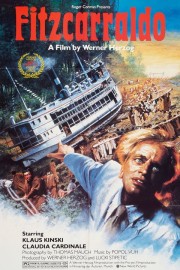Fitzcarraldo
Werner Herzog’s “Fitzcarraldo” is tedious, and a little boring, for roughly half of its 158-minute running time. It matters not, however, because the main event of the film, the reason for its existence, occurs in the second half of the film. The film lacks the haunting momentum and power of “Aguirre, the Wrath of God,” but it’s every bit as spellbinding as “Aguirre” when it counts, when Herzog, probably the most visionary filmmaker working now, does the unthinkable- he and his crew carry a 360-ton ship over a mountain, from one river to another. Another filmmaker would have just used miniatures and special effects to accomplish this task, but Herzog actual does it. It’s one of the great spectacles in cinematic history, and it could only happen from one director.
Werner Herzog is a filmmaker for artists to love. He straddles between narrative features and documentaries effortlessly, and interweaves fact and fiction beautifully, where there is truth in his narrative work, and some fiction in his documentaries, when fitting. I still have a ways to go, but I make it a point to catch his new films as much as I can, and one of my favorite uses of 3D is in his 2011 “Cave of Forgotten Dreams,” about the oldest cave drawings known to man in France. Few films have utilized 3D with the sense of purpose and power that film did, and it’s a film as rich in imagination as “Aguirre” or “Fitzcarraldo.” He was a favorite filmmaker of the late Roger Ebert, and it was Ebert’s appreciation for him that really drew me to Herzog’s work. The wild man days of filming in remote locations, or submitting to the “voodoo of location,” as Herzog calls it, for something like his “Nosferatu” remake, are gone, but he remains one of the most distinctive voices and visions in modern movies. Like Tarkovsky, plot is a moot point, and only images matter. Nowhere else in Herzog’s career has that been more true than it is in “Fitzcarraldo.”
The filming of “Fitzcarraldo” was chronicled in the documentary, “Burden of Dreams,” which I have yet to see, but the legend is well-documented. The story is inspired by a rubber baron, Carlos Fitzcarrald, who was living in Peru, and who wanted to expand his business deep into the jungle. To get to a remote piece of land, he took a ship from one river system to another over a mountain. His ship was smaller, and takes over in pieces, than the one Brian Sweeney Fitzgerald (known as “Fitzcarraldo” by the natives, and played by Klaus Kinski) carries over a mountain in one piece. His vision is less inspired by profit- he is a wanna-be rubber baron, and his lover (Claudia Cardinale) runs a brothel- but by a love of opera. He wants to build an opera house deep in the jungle, and have a famous opera singer (Enrico Caruso) sing there. He will use the profits from the rubber trees in the undeveloped land to fund it, and must enlist indigenous people to help take his steamship over the mountain. Apart from the obvious dangers with such an endeavor, there are also perilous rapids to contend with even if they get the ship across, as well as the danger the indigenous people of the region present. Seeing Fitzcarraldo, wild-eyed in his obsession, blaring Caruso in the jungle, as the ship makes its way down the rivers, is worth sitting through the film’s first half alone.
I think I’ve seen “Fitzcarraldo” three times now, and each time, the first half has been, honestly, boring to me. Knowing the spectacle of the ship up the mountain is coming, it’s hard to sit through what takes place before it, after Fitzcarraldo and his lover take in the opera, and Caruso, after traveling a long way on a small boat to get there. The beginning is as powerful as Herzog has ever staged in its way, but it can’t make up for the tedious nature of deal-making and talking about his obsession we are given before he hits the river with his steamship. When they get on the river, the film comes alive, as does Herzog’s filmmaking and, more importantly, Kinski’s wild flair as a performer. The idea that Jason Robards once played Kinski’s role is, honestly, crazy to me, but he was until dysentery forced him to pull out, leaving Herzog to turn to his eccentric “Aguirre” star, and Kinski does not disappoint. He and Cardinale are really the only people who keep us watching after the beginning of the film, but we know the real intensity in Kinski’s performance will come out on the river. The man, whom Herzog hated as an individual, but loved as an actor, has an energy to him that no one can duplicate, and as he was perfect for “Aguirre,” he’s more so in “Fitzcarraldo.” Both are about obsessive quests that make the travelers crazy, and feel doomed. Fitzcarraldo accomplishes his task, but loses much in doing so. Watching him do it is one of the great cinematic experiences, even if the movie Herzog made isn’t “great” in the way he usually think of that term.










